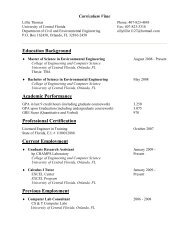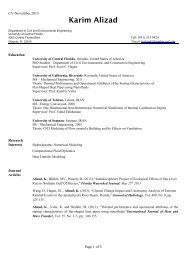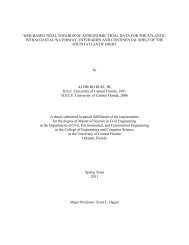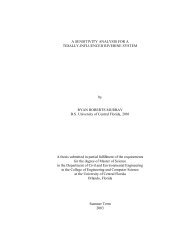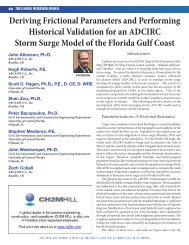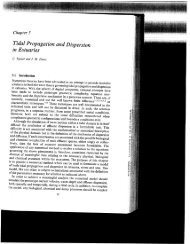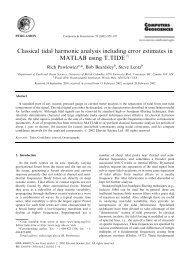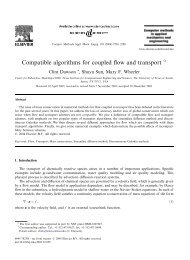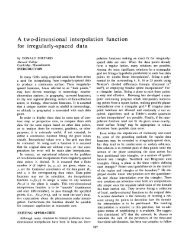Topographic accuracy assessment of bare earth lidar-derived ...
Topographic accuracy assessment of bare earth lidar-derived ...
Topographic accuracy assessment of bare earth lidar-derived ...
You also want an ePaper? Increase the reach of your titles
YUMPU automatically turns print PDFs into web optimized ePapers that Google loves.
Advances in Water Resources 52 (2013) 165–177Contents lists available at SciVerse ScienceDirectAdvances in Water Resourcesjournal homepage: www.elsevier.com/locate/advwatres<strong>Topographic</strong> <strong>accuracy</strong> <strong>assessment</strong> <strong>of</strong> <strong>bare</strong> <strong>earth</strong> <strong>lidar</strong>-<strong>derived</strong> unstructured meshesMatthew V. Bilskie ⇑ , Scott C. HagenDepartment <strong>of</strong> Civil, Environmental, and Construction Engineering, University <strong>of</strong> Central Florida, Orlando, FL 32816, USAarticleinfoabstractArticle history:Received 11 May 2012Received in revised form 16 August 2012Accepted 11 September 2012Available online 20 September 2012Keywords:Shallow water equationsUnstructured meshLidarDEMStorm surgeAccuracyThis study is focused on the integration <strong>of</strong> <strong>bare</strong> <strong>earth</strong> <strong>lidar</strong> (Light Detection and Ranging) data intounstructured (triangular) finite element meshes and the implications on simulating storm surge inundationusing a shallow water equations model. A methodology is developed to compute root mean squareerror (RMSE) and the 95th percentile <strong>of</strong> vertical elevation errors using four different interpolation methods(linear, inverse distance weighted, natural neighbor, and cell averaging) to resample <strong>bare</strong> <strong>earth</strong> <strong>lidar</strong>and <strong>lidar</strong>-<strong>derived</strong> digital elevation models (DEMs) onto unstructured meshes at different resolutions. Theresults are consolidated into a table <strong>of</strong> optimal interpolation methods that minimize the vertical elevationerror <strong>of</strong> an unstructured mesh for a given mesh node density. The cell area averaging method performedmost accurate when DEM grid cells within 0.25 times the ratio <strong>of</strong> local element size and DEMcell size were averaged. The methodology is applied to simulate inundation extent and maximum waterlevels in southern Mississippi due to Hurricane Katrina, which illustrates that local changes in topographysuch as adjusting element size and interpolation method drastically alter simulated storm surgelocally and non-locally. The methods and results presented have utility and implications to any modelingapplication that uses <strong>bare</strong> <strong>earth</strong> <strong>lidar</strong>.Ó 2012 Elsevier Ltd. All rights reserved.1. IntroductionTwo dimensional hydrodynamic models governed by forms <strong>of</strong>the Navier–Stokes equations have been increasingly used to assessrisk <strong>of</strong> urban flooding [1–5]. Light Detection and Ranging (<strong>lidar</strong>)technology allows rapid collection <strong>of</strong> ground measurements withvertical errors on the order <strong>of</strong> ±15 cm across large areas whichcan be used to parameterize the terrain in hydrodynamic flowmodels [1,3,4,6–10]. Applying finite element or finite volumeschemes allow modelers to have fine mesh resolution in areaswhere highly accurate solutions are required (e.g. near the shoreline,levees, roadbeds, urban regions, etc.) and have coarse meshresolution in areas outside the focus region (e.g. deep water)[11–13]. Incorporating high resolution <strong>lidar</strong> data into a high resolutionfinite element or volume mesh allows for improved terraindescription resulting in more accurate results within deterministichydrodynamic flow models [14].Lidar provides a means to incorporate high-resolution threedimensionaldata into a high quality digital elevation model(DEM) over wide areas [15–22]. A DEM is a collection <strong>of</strong> squarepixels (grid cells) defined at a regularly spaced interval (grid size)where the pixel value is the elevation. A digital terrain model(DTM) is used when the elevation data is <strong>bare</strong> <strong>earth</strong> and digital surfacemodel (DSM) when the elevation data contains <strong>bare</strong> <strong>earth</strong>,⇑ Corresponding author.E-mail address: Matt.Bilskie@gmail.com (M.V. Bilskie).vegetation (e.g. canopy height), and buildings [23,24]. In this study,DEM and DTM are used interchangeably. Since a DEM is an approximate(i.e. discrete) representation <strong>of</strong> the natural ground surface(i.e. continuous), there is a difference between the true surface <strong>of</strong>the <strong>earth</strong> and the surface represented by a DEM (DEM error)[25]. Many studies have shown that source data density, terrain,landcover type, interpolation method, and grid size affect DEM error[26–34]. However, there is an absence in the literature on topographicerror associated with unstructured meshes used in shallowwater flow models.State-<strong>of</strong>-the-art hydraulic flow models emphasize the horizontalplacement <strong>of</strong> mesh nodes to capture hydraulically significanttopographic features (e.g. ridges and valleys) and they rely on airborne<strong>bare</strong>-<strong>earth</strong> <strong>lidar</strong> to assign elevations to mesh nodes[1,3,21,14,35–37]. However, there is an inadequacy in both the literatureand in commercially available GIS s<strong>of</strong>tware packages toefficiently, accurately and defensibly resample <strong>bare</strong> <strong>earth</strong> <strong>lidar</strong> tomodel nodes as well as assess the vertical elevation error associatedwith an interpolation method and/or model node density. Inthis study, it is postulated that the size <strong>of</strong> the mesh element affectsthe <strong>accuracy</strong> <strong>of</strong> the ground surface as represented by the numericalmodel and the simulated water levels and currents. This study alsotests the performance <strong>of</strong> different interpolation methods used toresample <strong>bare</strong> <strong>earth</strong> <strong>lidar</strong> onto the model nodes. An under-performinginterpolation scheme may increase the topographic error<strong>of</strong> the mesh, ultimately leading to inaccurate results (e.g. extent<strong>of</strong> storm surge inundation). In other words, the <strong>accuracy</strong> <strong>of</strong> the0309-1708/$ - see front matter Ó 2012 Elsevier Ltd. All rights reserved.http://dx.doi.org/10.1016/j.advwatres.2012.09.003
166 M.V. Bilskie, S.C. Hagen / Advances in Water Resources 52 (2013) 165–177Fig. 1. National Elevation Dataset (NED) around the location <strong>of</strong> the study sites (gold) in southern Mississippi. (For interpretation <strong>of</strong> the references to color in this figurelegend, the reader is referred to the web version <strong>of</strong> this article.)<strong>bare</strong> <strong>earth</strong> <strong>lidar</strong> should be maintained within a computationalmesh.Marks and Bates [7] examined the effects <strong>of</strong> using survey mapbasedDEMs and <strong>bare</strong> <strong>earth</strong> <strong>lidar</strong> as source elevations for meshnodes for use in a two-dimensional floodplain flow model (TELE-MAC-2D [38]). Both source elevation datasets were interpolatedusing a linear inverse distance weighting <strong>of</strong> the four closest datapoints to each mesh node, although up to 40 <strong>lidar</strong> points werefound within mesh elements. Differences between the <strong>lidar</strong> <strong>derived</strong>-meshand the map-based DEM were as high as 14.4 m. Smallchanges in topography directly affected the simulated floodhydraulics. They concluded that a sophisticated method is neededto resample <strong>lidar</strong> to nodal points because <strong>of</strong> the high degree <strong>of</strong> dataredundancy with the dense <strong>lidar</strong> (e.g. ratio <strong>of</strong> node points to <strong>lidar</strong>points is low). Rego and Li [2] produced a finite volume coastalstorm surge model <strong>of</strong> Louisiana and Texas, using FVCOM [39] with<strong>lidar</strong> as the data source for the overland topography; howeverthere was no mention <strong>of</strong> how the <strong>bare</strong> <strong>earth</strong> points were interpolatedto the computational mesh. A parallel two-dimensional,Godunov-type, shallow-water code (ParBreZo [4]) to simulatehigh-resolution flood inundation at the regional scale was developedand uses a bin-tree mesh with elevations obtained via directlookup from a 10 m <strong>lidar</strong>-<strong>derived</strong> DTM [4]. Westerink et al. [35],Bunya et al. [3], and Dietrich et al. [1] have developed a series AD-CIRC [40] storm surge models for southern Louisiana using NED(National Elevation Dataset) [41,42] and topographic <strong>lidar</strong>. Wester-
M.V. Bilskie, S.C. Hagen / Advances in Water Resources 52 (2013) 165–177 167ink et al. [35] employed an element based gathering–averagingprocedure (i.e. grid-scale filtering) from the NED data, Bunyaet al. [3] does not mention the method <strong>of</strong> interpolating the <strong>lidar</strong>to the mesh, and the most recent version <strong>of</strong> the southern Louisianastorm surge model (‘‘SL16’’) applied overland <strong>lidar</strong> via a mesh-scaleaveraging scheme [1].The overall goal <strong>of</strong> this research is to efficiently resample <strong>bare</strong><strong>earth</strong> <strong>lidar</strong> onto an unstructured mesh without losing relevant terraininformation that may alter the natural physics <strong>of</strong> shallowwater flow. A methodology is presented to quantify topographicelevation error in a DEM and unstructured mesh, and an interpolationmethod is developed to resample a <strong>lidar</strong>-<strong>derived</strong> DEM to meshnodes efficiently and accurately. Lastly, an application <strong>of</strong> the methodologyto southern Mississippi (Hurricane Katrina) demonstrateslocal and non-local effects <strong>of</strong> topographic errors on simulatedstorm tide.2. Materials and methods2.1. Study siteThe study area is the lower Pascagoula River floodplain locatedin southern Mississippi. For the analysis <strong>of</strong> this study, the coastalfloodplain is split into three study sites (west, north, and east)(Fig. 1). The west, north, and east sites have an area <strong>of</strong> 97.6, 20.9,and 76.1 km 2 , respectively. The Pascagoula River flows into PascagoulaBay via the East and West Pascagoula Inlets. Marshlandsdominate near the shoreline except near the East Inlet where thereis developed land and a shipping port. Upland <strong>of</strong> the marsh, much<strong>of</strong> the floodplain consists <strong>of</strong> dense forest (Table 1).2.2. Lidar dataPre-Katrina <strong>lidar</strong> data for southern Mississippi were obtainedfor Jackson (February 2005), Hancock (February 2005), and HarrisonCounties (March 2004) [44]. The details <strong>of</strong> the <strong>lidar</strong> data collectioneffort can be found in a series <strong>of</strong> reports from the dataacquisition vendor, EarthData International [45–47]. The data weredelivered in classified LAS and ASCII XYZ formats for the threedimensionalpoint cloud and <strong>bare</strong> <strong>earth</strong> points. The <strong>bare</strong> <strong>earth</strong>points (LAS class 2) used in this study were classified by EarthDatausing proprietary methods to filter out non-ground points.CheckDEM, a proprietary s<strong>of</strong>tware program by EarthData International,was used to validate a set <strong>of</strong> control points (groundtruth)and assess the <strong>accuracy</strong> <strong>of</strong> the <strong>lidar</strong> dataset. Each control point wascompared to a DEM <strong>derived</strong> from the <strong>bare</strong>-<strong>earth</strong> points. Using onlythe <strong>bare</strong>-<strong>earth</strong> points, a statistical <strong>assessment</strong> <strong>of</strong> Jackson, Hancock,Table 1Percentage <strong>of</strong> landcover (1992 NLCD [43]) enclosed within each test site.1992 NLCD classification WestzoneNorthzoneEastzone11 – Open Water 1.9 8.7 3.421 – Low Intensity/Residential 6.9 0.0 15.822 – High Intensity/Residential 0.6 0.0 4.323 – Commercial/Industrial/2.8 0.8 11.6Transportation31 – Bare Rock/Sand/Clay 0.2 0.0 0.433 – Transitional 2.4 0.0 0.541 – Deciduous Forest 3.0 0.3 1.342 – Evergreen Forest 36.4 0.1 11.143 – Mixed Forest 13.7 0.0 5.181 – Pasture/Hay 3.2 0.1 3.182 – Row Crops 1.3 0.1 2.085 – Urban/Recreational Grass 3.6 0.0 17.691 – Woody Wetlands 9.0 0.9 9.592 – Emergent Herbaceous Wetlands 15.2 88.9 14.4and Harrision Counties resulted in an RMSE <strong>of</strong> 7.5, 4.4, and 6.12 cmand an <strong>accuracy</strong> <strong>of</strong> 14.7, 8.6, 12 cm, respectively [44–47].2.3. <strong>Topographic</strong> <strong>accuracy</strong> <strong>assessment</strong> methodologyPreliminary test sites (three in southern Mississippi and two insoutheastern Louisiana) are used to develop and validate the methodologyfor computing elevation errors between DEMs andunstructured finite element meshes (<strong>bare</strong> <strong>earth</strong> <strong>lidar</strong> data forsoutheastern Louisiana are obtained from Atlas: The LouisianaStatewide GIS [48]) [49,50]. For each preliminary test site, a boundaryis constructed and <strong>of</strong>fset, forming a transition zone to eliminateedge effects. Within the interior boundary, the <strong>lidar</strong> is sub-divided,randomly, into a training and test dataset, containing 90% and 10%<strong>of</strong> the points, respectively. The ratio <strong>of</strong> training to test points yieldsenough data points to test the quality <strong>of</strong> the processed data withoutdegrading the <strong>bare</strong> <strong>earth</strong> <strong>lidar</strong> data itself as well as provide asufficient population <strong>of</strong> points for statistical calculations (thismethod is not intended to examine the geodetic <strong>accuracy</strong> <strong>of</strong> thecollected <strong>bare</strong> <strong>earth</strong> <strong>lidar</strong>) [18,34]. The training dataset, mergedwith the <strong>bare</strong> <strong>earth</strong> points in the transition zone, are used to generatetraining DEMs (training-<strong>derived</strong> DEM) and interpolate to finiteelement meshes at different resolutions. The test dataset is used toassess vertical errors in elevation. The focus was on examining howinterpolating functions along with linear triangular elements andraster DEMs predict and/or represent the vertical component <strong>of</strong>source data [34].Three interpolation methods (linear, IDW, and natural neighbor[NN]) are used to interpolate the <strong>bare</strong> <strong>earth</strong> points and training-<strong>derived</strong>DEMs to unstructured meshes. These methods are easily employedby the s<strong>of</strong>tware program SMS 10.0 [51]. In addition, a fourthmethod, cell area (CA) averaging is tested. For interpolation <strong>of</strong> theDEM to a mesh, the cell area averaging scheme is employed withseveral variations. First, a single cell average (direct lookup) assignsthe value <strong>of</strong> the DEM cell that overlays a given mesh node. Further,the nine CA averaging technique averages the nine DEM grid cellssurrounding a mesh node. CA averaging <strong>of</strong> 25, 49, 81, 169, etc. cellsare used in the same fashion. The CA interpolation method is testedto determine the relationship between element size, DEM grid size,and the number <strong>of</strong> averaging cells (i.e. dimensions <strong>of</strong> the cell averagingwindow).2.4. Lidar-<strong>derived</strong> DEM <strong>accuracy</strong> <strong>assessment</strong>Elevations <strong>of</strong> the test points (Section 2.2) were compared to seventraining-<strong>derived</strong> DEMs (with resolutions <strong>of</strong> 1.25, 2.5, 5, 10, 20,40, and 80 m) for each test site (west, north and east) to computevertical elevation errors. The test points were assumed to be thetrue observed ground elevation and the elevation from the training-<strong>derived</strong>DEM (DEM generated from the training datasetmerged to the transition zone dataset) are the interpolated elevation.Based on common methods to quantify DEM error, severalmeasures were computed: mean error (ME), mean absolute error(MAE), and root mean square error (RMSE) [25,26,52]. ME, MAE,and RMSE were computed at each test point, M z ðx; yÞ, to the interpolatedvalue in the DEM, I z ðx; yÞ:ME ¼ 1 nX ni¼1X nðM z ðx; yÞ I z ðx; yÞÞ ð1ÞMAE ¼ 1 ðjM z ðx; yÞ I z ðx; yÞjÞ ð2Þni¼1vffiffiffiffiffiffiffiffiffiffiffiffiffiffiffiffiffiffiffiffiffiffiffiffiffiffiffiffiffiffiffiffiffiffiffiffiffiffiffiffiffiffiffiffiffiffiffiffiffiffiffiffiffiu1X nRMSE ¼ t ðM z ðx; yÞ I z ðx; yÞÞ 2ð3Þni¼1where n is the number <strong>of</strong> test points.
168 M.V. Bilskie, S.C. Hagen / Advances in Water Resources 52 (2013) 165–177Fig. 2. Large-scale western North Atlantic tidal model domain (WNAT) unstructured finite element mesh and inset box <strong>of</strong> study area.Table 2Description <strong>of</strong> the 21.5 day ADCIRC astronomic tide and storm surge simulation.Simulation Total run time Ramp time Steady-state time Run start UTC Run end UTCTides 15.5 10.0 5.5 10 August 2005 0:00 25 August 2005 12:00Tides + Katrina 6.0 1.0 5.0 25 August 2005 12:00 31 August 2005 12:002.5. Lidar-<strong>derived</strong> unstructured mesh <strong>accuracy</strong> <strong>assessment</strong>The elevations <strong>of</strong> the test points (Section 2.2) were comparedto four equilateral triangular finite element meshes (20, 40, 80,and 160 m). Equilateral elements were used because they correspondto a regular interval and they are the most numerically stable(60° interior angles) when used in finite element modes [13].RMSE (Eq. (3)) was computed to determine elevation error as wellas vertical <strong>accuracy</strong>. Vertical <strong>accuracy</strong> is defined as ‘‘the linearuncertainty value, such that the true or theoretical location <strong>of</strong>the points fall within ± <strong>of</strong> that linear uncertainty value 95% <strong>of</strong>the time’’ (Appendix A, Section A.3) [53]. Typically, when determiningthe <strong>accuracy</strong> <strong>of</strong> a <strong>lidar</strong>-based TIN (triangular irregular network)from ground truth checkpoints, topographic <strong>accuracy</strong> iscomputed as (assuming the errors follow a normal distribution)[53–55]:Accuracy ¼ 1:96 RMSEð4Þwhere RMSE is computed by Eq. (3). Recent work has shown thaterror distribution resulting from <strong>lidar</strong>-<strong>derived</strong> DEMs tend to not followa normal distribution, meaning alternative methods <strong>of</strong> computing<strong>accuracy</strong> for the DTM are necessary [56–58,9,59].To test the normality <strong>of</strong> the elevation errors, normality <strong>assessment</strong>s<strong>of</strong> two small test sites located within the north (marsh)and east (urban) zones were made. Histograms and normalizedQ–Q plots were generated for visual inspection <strong>of</strong> normality. Measures<strong>of</strong> normality (skewness and Kurtosis) and tests for normality(Kolmogorov–Smirnov test using Lilliefors significance correlationand Shaprio–Wilk test) [60,61] were used to determine if elevationerrors follow a normal distribution. The analysis was performed forthe population <strong>of</strong> all elevation errors as well as with outliers removed.Outliers were defined as values having an absolute Z-score<strong>of</strong> three or greater (p. 42) [62]:Z-score ¼ x Dzr Dzx Dzð5Þ
M.V. Bilskie, S.C. Hagen / Advances in Water Resources 52 (2013) 165–177 169wind penetration; and Z 0 is a anisotropic parameter that adjustthe wind boundary layer based on upwind conditions [63]. Theseparameters were assigned based on established lookup tables from1992 NLCD [43] dataset and interpolated to the ADCIRC mesh [3].Based on recent studies using similar methods, it can be expected,with the resolution outside the three regions and the methods employedto represent surface roughness that the model will performsatisfactorily for hurricane storm surge simulations.The four mesh variations were included in a simulation <strong>of</strong> astronomictides along with winds and pressures representing HurricaneKatrina using the two-dimensional, depth-integrated,hydrodynamic code, ADCIRC-2DDI [40]. ADCIRC solves the depthintegratedshallow water equations in the form <strong>of</strong> the GeneralizedWave Continuity Equation (GWCE) in spherical coordinates [64–67].A 21.5 day simulation was performed, divided into two separatesimulations (Table 2). First, a 15.5 day astronomic tide simulationwas performed from a cold start on 08/10/2005 00:00 UTC. Next,a 6 day simulation <strong>of</strong> astronomic tides and wind and pressuresfrom Hurricane Katrina was performed from a hot start <strong>of</strong> the prior15.5 day tide only model, yielding a total simulation length <strong>of</strong>21.5 days. The inundation extent and maximum water levels foreach <strong>of</strong> the four simulations were saved as output for subsequentcomparison.3. Results and discussion3.1. Lidar-<strong>derived</strong> DEM <strong>accuracy</strong> <strong>assessment</strong>Fig. 3. Root mean square error (RMSE) and mean absolute error (MAE) <strong>of</strong> groundelevations <strong>of</strong> each DEM.where x Dz is the elevation error at a given point, x Dz is the mean elevationerrors in the test dataset, and r Dz is the standard deviation <strong>of</strong>all elevation errors in the test dataset.2.6. Hydrodynamic model description and setupEach <strong>of</strong> the four equilateral finite element meshes, with elevationsobtained using the interpolation method that produced thelowest RMSE from the 5 m <strong>lidar</strong>-<strong>derived</strong> DEM, were merged witha larger unstructured finite element mesh <strong>of</strong> the adjacent floodplain,Pascagoula River, Gulf <strong>of</strong> Mexico, and Atlantic Ocean(Fig. 2) [37]. The unstructured mesh <strong>of</strong> the adjacent floodplainwas generated to mimic standard practices used in overland stormsurge modeling. Element resolution in the river ranges from 30 to60 m in the Pascagoula River, 100–150 m along the coastal shorelineand adjacent floodplain, and up to 200 m at the model boundary(10 m elevation contour). Spatially varying surface roughnessparameters (Manning’s n, vegetation canopy, and surface directionaleffective roughness length [Z 0 ]) were incorporated into each<strong>of</strong> the four models. Manning’s n is resistance to flow, mainly fromdrag and skin friction; vegetation canopy is the adjustment forThe ME, MAE, and RMSE between the measured test points andthe interpolated value found in the DEM were computed at thethree study sites (Fig. 3) (Table 3). From the ME, the training-<strong>derived</strong>DEMs under-predicted ground elevations for grid sizes(D DEM ) <strong>of</strong> 5 m or less and ground elevations were over-predictedwhen the grid size was larger than 5 m, with the exception <strong>of</strong>the 40 m DEM across the west study site. Overall, MAE and RMSEbetween the west and east study sites were similar and lowerMAE and RMSE were found in the north site. MAE in the 40 mDEM were 22.02, 22.70, and 12.84 cm and RMSE was 38.63,44.39, and 17.31 cm, for the west, east, and north zones, respectively.Smaller grid sizes produced lower MAE and RMSE regardless<strong>of</strong> the study site. However, RMSE did not decrease further whenthe grid size fell below 5 m. When decreasing the grid size from5 to 2.5 m, RMSE is reduced by 1.5, 0.6, and 1.9 cm, for the west,north, and east test sites, respectively. Further reducing the gridsize from 2.5 to 1.25 m does not significantly reduce RMSE (lessthan 1 cm). This result is consistent with the Nyquist frequencytheory <strong>of</strong> digital signal processing when related to grid resolution[68], which states that a signal can be reconstructed if the samplingfrequency exceeds twice the source frequency [69]. Therefore,resampling the source elevation data to less than half <strong>of</strong> its originalpoint density produces asymptotic behavior in vertical elevationerrors. Conversely, increasing the DEM grid size from 5 to 10 m resultsin differences <strong>of</strong> 4.2, 1.8, and 5.4 cm for the west, north, andeast zones, respectively. As the DEM becomes coarser (larger gridcell size), it is unable to describe sub-scale undulations <strong>of</strong> theground surface, that are better represented by higher resolutionTable 3DEM mean error (ME) in cm for the three study sites.D DEM (m) 1.25 2.5 5 10 20 40 80West zone (N = 442981) 0.04 0.04 0.02 0.02 0.06 0.13 0.19North zone (N = 60835) 0.12 0.11 0.03 0.13 0.43 0.73 1.4East zone (N = 355967) 0.06 0.05 0.02 0.7 0.16 0.21 0.46
170 M.V. Bilskie, S.C. Hagen / Advances in Water Resources 52 (2013) 165–177DEMs; therefore, MAE and RMSE generally increase along with largerDEM grid cells.3.2. Lidar-<strong>derived</strong> unstructured mesh normality testHistograms and normalized Q–Q plots were generated alongwith computed skewness, Kurtosis, Kolmogorov–Smirnov testusing Lilliefors significance correlation, and Shaprio–Wilk test[60,61] to determine if the elevation errors follow a normal distribution.First, histograms and normalized Q–Q plots for all elevationerrors are visually inspected for normality for the marsh and urbantest sites (Fig. 4). Normality tests were conducted for two testssites to determine if normality <strong>of</strong> the elevation errors are affectedby varying landcover. The histograms reveal high peaks and longFig. 4. (A) Histogram and (B) normalized Q–Q plot for the marsh sample location. (C) Histogram and (D) normalized Q–Q plot for the urban sample location with outliers.Table 4Normality test results <strong>of</strong> error distribution between the two sample sites and test dataset.Sample site n Skewness Kurtosis Kolmogorov–Smirnov a Shapiro–WilkStatistic p-Value Statistic p-ValueUrban 3829 3.48 33.55 0.1182
M.V. Bilskie, S.C. Hagen / Advances in Water Resources 52 (2013) 165–177 171Fig. 5. Interstate exchange showing (A) large differences in <strong>bare</strong> <strong>earth</strong> elevations, (B) areas <strong>of</strong> high elevation error, (C) spatially varying <strong>lidar</strong> coverage, and (D) hightopographic variability along the interstate bridge (standard deviation <strong>of</strong> the 5 m digital elevation model [3 3 cell window]).Fig. 6. Root mean square error (RMSE) using the cell area (CA) method based on the5 m digital elevation model for the (A) west study site; (B) north study site; and (C)east study site.Fig. 7. Ninety-fifth percentile <strong>of</strong> the elevation errors using the cell area (CA)method based on the 5 m digital elevation model for the three study sites: (A) west;(B) north; and (C) east.
172 M.V. Bilskie, S.C. Hagen / Advances in Water Resources 52 (2013) 165–177Table 6Best performing cell area averaging method for each equilateral mesh at each test sitein terms <strong>of</strong> (A) RMSE and (B) 95th percentile <strong>of</strong> elevation errors.D M West North East(A)20 9 CA 9 CA 9 CA40 25 CA 25 CA 25 CA80 81 CA 81 CA 81 CA160 289, 361, 441 CA a 289, 361, 441 CA a 225, 289 CA a(B)20 DL 9 CA 9 CA40 9, 25 CA a 25, 49 CA a 25 CA80 49, 81 CA a 81 CA 81 CA160 225, 289, 361 CA a 169, 225, 289, 361 CA a 225, 289, 361 CA aCA = cell area; DL = direct lookup.a Multiple entries suggest values were within 1 cm <strong>of</strong> one another.Table 7Eq. (7) applied to several element sizes with a DEM size <strong>of</strong> 5 m.D M D DEM N CA1.25 5 0.0625 12.5 5 0.125 15 5 0.25 110 5 0.5 120 5 1 940 5 2 2580 5 4 81160 5 8 289tails in the error distribution, even when outliers are removed. Thenormalized Q–Q plots expose a sigmoid-type function rather thana linear fit to the straight line, which is also true <strong>of</strong> the distributionwith outliers removed.Values for skewness are negative and varied for each samplesite indicating asymmetry and the Kurtosis values are large depictinglong tails in the error distribution (Table 4). For each normalitytest, the null hypothesis (elevation errors follow a normal distribution)was rejected, even with outliers removed. All tests conductedverified that elevation errors for both sample sites do not follow anormal distribution indicating, for coastal Mississippi, normality inelevation errors are independent <strong>of</strong> ground cover type and therefore,the 95th percentile is used to compute topographic <strong>accuracy</strong>[23].3.3. Lidar-<strong>derived</strong> unstructured mesh <strong>accuracy</strong> <strong>assessment</strong>Generally, all interpolating methods performed similarly; however,the linear method typically resulted in lower RMSE. Smallermesh sizes (D M ) resulted in lower RMSE, regardless <strong>of</strong> the studysite (Table 5). The west and east study sites generally had largerRMSE as well as a large range in RMSE (50 cm), compared to thenorth test site, which corroborates that topographic gradients area large factor in DEM error [70,71]. The north study site containsless elevation error compared to the west and east study sites. Thisis mainly due to the low range <strong>of</strong> elevations in the marsh producinglow topographic relief. Further, large local vertical elevation er-Fig. 8. Maximum envelope <strong>of</strong> water (MEOW) for (A) 160 m; (B) 80 m; (C) 40 m; and (D) 20 m mesh version over the maximum <strong>of</strong> maximums (MOM).
M.V. Bilskie, S.C. Hagen / Advances in Water Resources 52 (2013) 165–177 173Fig. 9. The total inundation area (blue) over the inundation area from the MOM (red) near the Escatawpa River for (A) 160 m; (B) 80 m; (C) 40 m; and (D) 20 m mesh versionfor the red inset from Fig. 8. (For interpretation <strong>of</strong> the references to color in this figure legend, the reader is referred to the web version <strong>of</strong> this article.)rors were observed near areas <strong>of</strong> topographic roughness and not inareas <strong>of</strong> low <strong>lidar</strong> point density (Fig. 5). The interstate exchangeproduced relatively large elevation errors (±2 m) when <strong>lidar</strong> countwas high (18 returns per 100 m 2 ), but where the local variability inthe terrain (e.g. topographic slope) was large. Marsh areas generallyhad lower ranges in local slope, therefore producing lower errorsin vertical elevation.Performance <strong>of</strong> interpolating the training-<strong>derived</strong> 5 m DEM tothe meshes was similar to interpolating directly from the trainingdataset (points) [49]. RMSE increased when interpolating from thetraining-<strong>derived</strong> 10 m DEM, compared to the 5 m DEM [50].RMSE and vertical <strong>accuracy</strong> (95th percentile) are presented forvertical differences in elevation between the test dataset and eachtriangular mesh for the three test sites using the CA averagingmethod interpolated from the training-<strong>derived</strong> 5 m DEM (Figs. 6and 7). Small averaging windows resulted in lower RMSE for smallelement sizes and higher RMSE for large element sizes. Alternatively,a large averaging window resulted in lower RMSE for largeelements and higher RMSE for small elements. For a given cellaveraging window, there is a threshold with respect to mesh resolutionwhere benefits are gained (errors are reduced) by using thegiven cell averaging window versus a smaller or larger one. Theabove trends also generally occur for the 95th percentile <strong>of</strong> elevationerrors.Generally, the cell averaging method with the lowest RMSE(Table 6A) for a given element size matched the cell averagingmethod with the lowest RMSE (Table 6B). The best CA methodwas independent <strong>of</strong> the study site. The most dependent factorwas element size. An equation was developed from back calculatingthe results from Table 6. A constant coefficient <strong>of</strong> 0.25 wasfound to relate element and DEM grid cell size to the number <strong>of</strong>cells averaged (CA) to minimize vertical errors in elevation:N ¼ 0:25D MD DEM1 for N < 1CA ¼½2ðNÞþ1Š 2 for N P 1where N is the number <strong>of</strong> DEM grid cells radiating omnidirectionallyfrom the DEM cell containing the node in question. Table 7 showsEq. (7) applied to a 5 m DEM with element sizes ranging from 1.25to 160 m. The results are identical to those in Table 6A, for elementsizes <strong>of</strong> 20 m and greater. This implies that each preliminary testsite was capable <strong>of</strong> producing the relationship between DEM gridsize, element size, and the dimensions <strong>of</strong> the optimal averagingwindow. A direct lookup (1 cell average) method is used when elementshave edge lengths less than 20 m and the data source is a 5 mDEM. For example, a 10 m element should not average neighboringDEM grid cells because the area <strong>of</strong> the neighbors is too large comparedto the area <strong>of</strong> the element and ultimately not representative<strong>of</strong> the element area, which would introduce error to the mesh node<strong>of</strong> interest.ð6Þð7Þ
174 M.V. Bilskie, S.C. Hagen / Advances in Water Resources 52 (2013) 165–177Fig. 10. Equilateral meshes contributing to the maximum <strong>of</strong> maximums (MOM).Table 8The total inundation area and percentage from the MOM for each test site.Test site Inundated area (km 2 ) and percentage (%)160 m 80 m 40 m 20 mWest 56.14(57.53%)58.07(59.51%)56.00(57.39%)57.27(58.69%)North 20.89 (100%) 20.89 (100%) 20.89 (100%) 20.89 (100%)East 58.90(77.43%)60.27(79.23%)60.15(79.07%)61.00(80.19%)3.4. Hydrodynamic simulationsA comparison <strong>of</strong> maximum inundation extent and maximumwater levels resulting from storm surge simulation using 160, 80,40, and 20 m variations <strong>of</strong> the Pascagoula floodplain mesh is presented.Note that this study compromises an intercomparison <strong>of</strong>these four simulation results and is not a model validation study.Recall, the only difference between each mesh is within the testsite locations, which include equilateral elements and transitionzones, as bounded by the equilateral boundary shown in Fig. 8.The maximum <strong>of</strong> maximums (MOM) is the overall extent <strong>of</strong> surgeinundation resulting from the combination <strong>of</strong> the maximum envelopes<strong>of</strong> water (MEOWs) simulated by separate applications <strong>of</strong>each mesh. The MEOW is the maximum elevation reached at eachnode for a particular simulation; however, for clarity, only the extent<strong>of</strong> coverage is provided in Figs. 8 and 9. The spatially-variabledifference between the MEOWs is presented in Fig. 10. The MOM iscomputed by determining the maximum water surface elevation ateach computational node among each <strong>of</strong> the four simulations.Much <strong>of</strong> the land area within each test site (orange 1 boundary) isinundated, with the center zone completely flooded (Table 8).Adjustments in the topographic representation within the testsites affect the simulated MEOW both locally and non-locally(Fig. 8). Differences in the MEOWs are most noticeable in upper extents<strong>of</strong> the floodplain, especially within the upper Escatawpa Riverbasin with the largest difference noticed in the 40 m mesh, and thesmallest in the 20 m mesh (Fig. 9). The 40 m mesh tends to restrainflow as the other meshes tend to allow more inundation. The elements<strong>of</strong> the 40 m mesh resolve ridges but not valley features inthe terrain.Fig. 10 highlights the mesh that contributes to the highest waterlevel in the MOM. The 160 m mesh contributed many <strong>of</strong> the highestwater levels in the low-lying marsh regions and within creeksand tributaries; the 80 m mesh produced the highest water levelsalong the coastal shoreline, coastal marsh, and in shallow regions<strong>of</strong> Pascagoula and Grand Bay; the 40 m mesh added the highest
M.V. Bilskie, S.C. Hagen / Advances in Water Resources 52 (2013) 165–177 175Fig. 11. Differences in maximum water levels between the (A) 160 and 20 m; (B) 160 and 40 m; (C) 160 and 80 m; (D) 80 and 20 m; (E) 80 and 40 m; and (F) 40 and 20 mequilateral mesh simulations.water levels <strong>of</strong>fshore; and the 20 m mesh supplied the highestwater level in the farthest extents <strong>of</strong> the inundation area whichare among the highest topographic elevations. The 20 m elementsresolve both the ridge and valley features so that water is not onlyprohibited, but promoted in small creeks and channels, allowingthe water to propagate farther upstream and inundate a greater ex-
176 M.V. Bilskie, S.C. Hagen / Advances in Water Resources 52 (2013) 165–177Table 9Differences in total inundated area among each mesh version.Mesh difference Difference in inundated area (km 2 )160–20 m 2.43160–40 m 14.53160–80 m 9.7280–20 m 7.2980–40 m 4.8140–20 m 12.10tent. The 160 and 80 m meshes do not resolve ridges and valleys aswell as the 20 m mesh; therefore, flow is not prohibited. The 160 melements smooth out the terrain allowing more flow, resulting inincreased water levels within the majority <strong>of</strong> the floodplain. Themore resolved meshes (i.e. smaller elements) enable storm surgeto inundate where the topography and physics <strong>of</strong> shallow waterflow would naturally have storm surge flooding.Fig. 11 and Table 9 present the difference in maximum waterlevels and inundated areas between each <strong>of</strong> the four mesh variations,respectively. Differences in inundation less than 1 cm andareas that remained dry during the simulation are colored as transparent.2 Differences in water levels are as much as 16 cm for marshareas between the 160 and 20 m mesh. Differences over 30 cm inmaximum water levels are found between the 160 and 40 m mesh.The 80 m mesh produced over 20 cm in higher water levels comparedto the 40 m mesh. The largest difference occurred betweenthe 40 and 20 m mesh simulations. The 20 m mesh includes almost50 cm in maximum water level over the 40 m mesh in the upperreach <strong>of</strong> the Escatawpa River.Results show a local and non-local response to both inundationextent and maximum water levels when adjusting local topography.In other words, the representation <strong>of</strong> the ground surface hasa strong influence on inundation extent and total maximum waterlevels in areas outside the adjusted topographic areas. Floodplainmapping and analysis rely heavily on flood extent for differentstorm return periods. Not including a correct <strong>bare</strong> <strong>earth</strong> terrainrepresentation in hydraulic flood models could result in inaccurateflood maps as the most significant differences were found at theedge <strong>of</strong> the inundation front.4. ConclusionsThis study investigated vertical elevation errors for differentmethods <strong>of</strong> parameterizing (i.e. interpolation) topography to anunstructured finite element mesh from <strong>bare</strong> <strong>earth</strong> <strong>lidar</strong> and <strong>lidar</strong><strong>derived</strong>DEMs and its affect on simulated inundation. It was demonstrated,by comparing interpolated elevations to measured <strong>bare</strong><strong>earth</strong> <strong>lidar</strong> values, that elevation error propagates and accumulatesin each component <strong>of</strong> terrain discretization: raw measurement <strong>of</strong>the terrain (i.e. <strong>bare</strong> <strong>earth</strong> <strong>lidar</strong>); DTM generation; and interpolationto a mesh. DEM grid cells inherently contain terrain error, attimes at higher levels than linear triangular elements, implyingthe mesh, even when interpolated from a DEM, can describe the<strong>bare</strong> <strong>earth</strong> terrain more accurately than its source data. For thisstudy, topographic error and <strong>accuracy</strong> are similar when using a5 m <strong>lidar</strong>-<strong>derived</strong> DEM or <strong>bare</strong> <strong>earth</strong> <strong>lidar</strong> to interpolate to a finiteelement mesh. Additionally, the distribution <strong>of</strong> vertical elevationerrors in the finite element mesh was shown to not follow a normaldistribution, which means alternative methods <strong>of</strong> computing <strong>accuracy</strong>are required.A tool to accurately resample <strong>lidar</strong> data to the discretizatedcomputational points <strong>of</strong> a model is necessary, since <strong>lidar</strong> typicallyincludes finer discretization than typical resolutions <strong>of</strong> both coastaland watershed hydraulic flood models. Therefore, a fundamentaland novel cell area averaging interpolation technique was developedand produced comparable results to traditional interpolationmethods (e.g. linear, IDW, and NN) when interpolating a <strong>lidar</strong>-<strong>derived</strong>DEM to an unstructured mesh. <strong>Topographic</strong> elevation errorswere found to be highly dependent on element size and the number<strong>of</strong> DEM cells averaged (DEM cell window). From this, a constantcoefficient <strong>of</strong> 0.25 was found to relate element and DEMgrid size to the number <strong>of</strong> cells averaged to minimize vertical terrainerror. This relationship determines the proper control volumearound a mesh node in which to obtain surrounding elevationsfrom a DEM.A direct utility <strong>of</strong> the presented methodology is not only toexamine topographic error, but to observe the effect terrain parameterizationhas on simulated inundation extent and water levels.With this, it was shown that small changes in topographic representationalter the extent <strong>of</strong> flooding and maximum water levels.Specifically, topographic modifications near the coast affected simulatedflood hydraulics upstream where the local topography wasun-altered. The methods and results presented have utility andimplications to river flood routing models, since gravity drivenflow is not limited to shallow water coastal modeling. Since largerelevation errors were found along high gradients in the terrain, futurework should explore application <strong>of</strong> these findings in conjunctionwith vertical feature delineation [14].AcknowledgementsThis research was funded in part by Award No. NFWMD-08-073from the Northwest Florida Water Management District(NWFWMD). The STOKES advanced research computing center(ARCC) (webstokes.ist.ucf.edu) provided computational resourcesfor storm surge simulations. The statements and conclusions arethose <strong>of</strong> the authors and do not necessarily reflect the views <strong>of</strong>the NWFWMD, STOKES ARCC, or their affiliates.References[1] Dietrich J, Westerink J, Kennedy A. Hurricane Gustav (2008) waves and stormsurge: hindcast, synoptic analysis, and validation in southern Louisiana. MonWeather Rev 2011;139(8):2488–522.[2] Rego J, Li C. On the receding <strong>of</strong> storm surge along Louisianas low-lying coast. JCoast Res 2009;SI56(2):1045–9.[3] Bunya S, Dietrich J, Westerink J, Ebersole B, Smith J, Atkinson J, et al. A highresolutioncoupled riverine flow, tide, wind, wind wave, and storm surgemodel for southeastern Louisiana and Mississippi. Part I: model developmentand validation. Mon Weather Rev 2010;128:345–77.[4] Sanders BF, Schubert JE, Detwiler RL. ParBreZo: a parallel, unstructured grid,Godunov-type, shallow-water code for high-resolution flood inundationmodeling at the regional scale. Adv Water Resour 2010;33(12):1456–67.[5] Bates PD, Dawson RJ, Hall JW, Horritt MS, Nicholls RJ, Wicks J, et al. Simplifiedtwo-dimensional numerical modelling <strong>of</strong> coastal flooding and exampleapplications. Coast Eng 2005;52(9):793–810.[6] Bates P, Marks K, Horritt M. Optimal use <strong>of</strong> high-resolution topographic data inflood inundation models. Hydrol Process 2003;17:537–57.[7] Marks K, Bates P. Integration <strong>of</strong> high resolution topographic data withfloodplain flow models. Hydrol Process 2000;14:2109–22.[8] Schubert JE, Sanders BF, Smith MJ, Wright NG. Unstructured mesh generationand landcover-based resistance for hydrodynamic modeling <strong>of</strong> urban flooding.Adv Water Resour 2008;31(12):1603–21.[9] Zandbergen PA. Characterizing the error distribution <strong>of</strong> <strong>lidar</strong> elevation data. IntJ Remote Sens 2011;32(2):409–30.[10] Council NR. Mapping the zone: improving flood map <strong>accuracy</strong>. Washington,DC: The National Academy Press; 2009.[11] Cobby DM, Mason DC, Horritt MS, Bates P. Two-dimensional hydraulic floodmodelling using a finite-element mesh decomposed according to vegetationand topographic features <strong>derived</strong> from airborne scanning laser altimetry.Hydrol Process 2003;17:1979–2000.[12] Salisbury MB, Hagen SC, Coggin D, Bacopoulos P, Atkinson J, Roberts HJ.Unstructured mesh development for the big bend region (Florida). FloridaWatershed J 2011;4(2):11–4.[13] Hagen S. Estimation <strong>of</strong> the truncation error for the linearized, shallow watermomentum equations. Eng Comput 2001;17:354–62.[14] Coggin D. A digital elevation model for Franklin, Wakulla, and Jeffersoncounties. Florida Watershed J 2011;4(2):5–10.[15] Lohr U. Digital elevation models by laser scanning. Photogrammet Rec1998;16(9):105–9.[16] Wehr A, Lohr U. Airborne laser scanning – an introduction and overview. JPhotogrammet Remote Sens 1999;54:68–82.
M.V. Bilskie, S.C. Hagen / Advances in Water Resources 52 (2013) 165–177 177[17] Lefsky M, Cohen W, Parker C, Harding D. Lidar remote sensing for ecosystemstudies. Bioscience 2002;52:19–30.[18] Liu X, Zhang Z, Peterson J, Chandra S. The effect <strong>of</strong> LiDAR data density on DEM<strong>accuracy</strong>. In: MODSIM07: International Congress on Modelling andSimulation: Land, Water and Environmental Management: IntegratedSystems for Sustainability. Christchurch, New Zealand; 2007.[19] Liu X, Zhang Z, Peterson J, Chandra S. Lidar-<strong>derived</strong> high quality ground controlinformation and DEM for image orthorectification. GeoInformatica2007;11(1):37–53.[20] Lloyd CD, Atkinson P. Deriving ground surface digital elevation models from<strong>lidar</strong> data with geostatistics. Int J Geograph Inform Sci 2006;20(5):535–63.[21] Coggin D. Lidar in coastal storm surge modeling: modeling linear raisedfeatures. Master’s thesis; 2008.[22] Medeiros S, Ali T, Hagen S. Development <strong>of</strong> a seamless topographic/bathymetric digital terrain model for Tampa Bay, Florida. Photogrammet EngRemote Sens 2011;77(12):1249–56.[23] Maune DF. Digital elevation model technologies and applications: the DEMusers manual. 2nd ed. Bethesda, Maryland: American Society forPhotogrammetry and Remote Sensing; 2007.[24] Sanders BF. Evaluation <strong>of</strong> on-line DEMs for flood inundation modeling. AdvWater Resour 2007;30:1831–43.[25] Shi W. Principles <strong>of</strong> modeling uncertainties in spatial data and spatialanalysis. Boca Raton, FL: CRC Press; 2010.[26] Desmet PJJ. Effects <strong>of</strong> interpolation errors on the analysis <strong>of</strong> DEMs. Earth SurfProc Land 1997;22:563–80.[27] Gong J, Li Z, Zhu Q, Zhou S, Zhou Y. Effects <strong>of</strong> various factors on the <strong>accuracy</strong> <strong>of</strong>DEMs: an intensive experimental investigation. Photogrammet Eng RemoteSens 2000;66(9):1113–7.[28] Schoorl J, Sonneveld M, Veldkamp A. Three-dimensional landscape processmodelling: the effect <strong>of</strong> DEM resolution. Earth Surf Process Land2000;25:1025–34.[29] Ali T. On the selection <strong>of</strong> an interpolation method for creating a terrain model(TM) from <strong>lidar</strong> data. In: American congress on surveying and mapping(ACSM) conference.[30] Li Z, Zhu Q, Gold C. Digital terrain modeling: principles andmethodology. London, New York, and Washington, DC: CRC Press; 2005.[31] Anderson ES, Thompson J, Crourse DA, Austin RE. Horizontal resolution anddata density effects on remotely sensed <strong>lidar</strong>-based DEM. Geoderma2006;132(3–4):406–15.[32] Fisher P, Tate N. Causes and consequences <strong>of</strong> error in digital elevation models.Prog Phys Geogr 2006;22(1):33–60.[33] Liu X, Zhang Z, Peterson J, Chandra S. Large area DEM generation usingairborne <strong>lidar</strong> data and quality control. In: 8th International symposium onspatial <strong>accuracy</strong> <strong>assessment</strong> in natural resources and environmental sciences.[34] Bater CW, Coops NC. Evaluating error associated with <strong>lidar</strong>-<strong>derived</strong> DEMinterpolation. J Comput Geosci 2009;35(2):289–300.[35] Westerink J, Luettich R, Feyen J, Atkinson J, Dawson C, Roberts H, et al. A basintochannel-scale unstructured grid hurricane storm surge model applied tosouthern Louisiana. Mon Weather Rev 2008;136:833–64.[36] Roberts HJ. Grid generation methods for high resolution finite element modelsused for hurricane storm surge prediction. Master’s thesis; 2004.[37] Hagen S, Zundel A, Kojima S. Automatic, unstructured mesh generation fortidal calculations in a large domain. Int J Comput Fluid Dynam2006;20(8):593–608.[38] Hervouet JM. TELEMAC modeling system: an overview. Hydrol Process2009;14(13):2209–10.[39] Chen C, Liu H, Beardsley RC. An unstructured grid, finite-volume, threedimensional,primitive equations ocean model: application to coastal oceanand estuaries. J Atmos Oceanic Technol 2003;20(1):159–86.[40] Luettich R, Westerink J. Formulation and numerical implementation <strong>of</strong> the 2D/3D ADCIRC finite element model version 44.XX; 2006.[41] Gesch D, Oimoen M, Greenlee S, Nelson C, Steuck M, Tyler D. The NationalElevation Dataset. Photogrammet Eng Remote Sens 2002;68(1):5–11.[42] Gesch D. The National Elevation Dataset. 2nd ed. Bethesda,Maryland: American Society for Photogrammetry and Remote Sensing; 2007.p. 99–118.[43] Vogelmann J, Howard S, Yang L, Larson C, Wylie B, Van Driel N. Completion <strong>of</strong>the 1990s national land cover data set for the conterminous united states fromlandsat thematic mapper data and ancillary data sources. Photogrammet EngRemote Sens 2001;67:650–2.[44] URS. Mississippi coastal analysis project compiled reports <strong>of</strong> HMTAP. Tech.Rep. Federal Emergency Management Agency; 2006.[45] International E. Harrison county, Mississippi <strong>lidar</strong> processing report. Tech.Rep.; 2005.[46] International E. Harrison county, Mississippi <strong>lidar</strong> acquisition report. Tech.Rep.; 2005.[47] International E. Elevation mapping Jackson and Hancock counties. MS <strong>lidar</strong>final project report. Tech. Rep.; 2005.[48] University L.S. Louisiana <strong>lidar</strong>; 2011.[49] Bilskie M. Influence <strong>of</strong> topographic elevation error on modeled storm surge.Master’s thesis; 2012.[50] Bilskie MV, Akhavian R, Hagen SC. Bare <strong>earth</strong> LiDAR to gridded topography forthe Pascagoula, MS: an <strong>accuracy</strong> <strong>assessment</strong>. In: Twelfth internationalconference on estuarine and coastal modeling.[51] Aquaveo. Surface-water modeling system; 2010.[52] Chaplot V, Darboux F, Bourennane H, Leguedois S, Silvera N, Phachomphon K.Accuracy <strong>of</strong> interpolation techniques for the derivation <strong>of</strong> digital elevationmodels in relation to landform types and data density. J Geomorphol2006;77:126–41.[53] FEMA. Appendix A, guidance for aerial mapping and surveying. Tech. Rep.Federal Emergency Management Agency; 2003.[54] ASPRS. ASPRS guidelines. Tech. Rep. American Society for Photogrammetry andRemote Sensing; 2004.[55] Greenwalt CR, Shultz ME. Principles <strong>of</strong> error theory and cartographicapplications. Tech. Rep.; 1962.[56] Zandbergen PA. Positional <strong>accuracy</strong> <strong>of</strong> spatial data: non-normal distributionsand a critique <strong>of</strong> the national standard for spatial data <strong>accuracy</strong>. Trans GIS2008;12(1):103–30.[57] Oksanen J, Sarjakoski T. Uncovering the statistical and spatial characteristics <strong>of</strong>fine toposcale DEM error. Int J Geogr Inform Sci 2006;20:345–69.[58] Aguilar FJ, Mills JP. Accuracy <strong>assessment</strong> <strong>of</strong> <strong>lidar</strong>-<strong>derived</strong> digital elevationmodels. Photogrammet Rec 2008;23(122):148–69.[59] Hasan A, Pilesjo P, Persson A. The use <strong>of</strong> <strong>lidar</strong> as a data source for digitalelevation models – a study <strong>of</strong> the relationship between the <strong>accuracy</strong> <strong>of</strong> digitalelevation models and topographical attributes in northern Peatlands. HydrolEarth Syst Sci Discuss 2011;8:5497–522.[60] Lilliefors H. On the Kolmogorov–Smirnov test for normality with mean andvariance unknown. J Am Statist Assoc 1967;62:399–402.[61] Shapiro S, Wilk M. An analysis <strong>of</strong> variance test for normality (completesamples). Biometrika 1965;52:591–9.[62] Mendenhall W, Sincich T. Statistics for engineering and the sciences. 5thed. Upper Saddle River, NJ: Pearson Prentice Hall; 2007.[63] Atkinson J, Roberts H, Hagen S, Zou S, Bacopoulos P, Medeiros S, et al. Derivingfrictional parameters and performing historical validation for an ADCIRC stormsurge model <strong>of</strong> the florida gulf coast. Florida Watershed J 2011:22–7.[64] Kinnmark I. The shallow water wave equations: formulation, analysis, andapplication. New York, NY: Springer-Verlag; 1985.[65] Kolar RL, Grey W, Westerink J, Luettich R. Shallow water modeling in sphericalcoordinates: equation formulation, numerical implementation, andapplication. J Hydraul Res 1994;32(1):3–24.[66] Westerink J, Luettich R, Muccino J. Modeling tides in the western northAtlantic using unstructured graded grids. Tellus 1994;46A:178–99.[67] Lynch D, Gray W. A wave equation model for finite element tidalcomputations. Comput Fluids 1979;7(3):207–28.[68] Hengl T. Finding the right pixel size. Comput Geosci 2006;32(9):1283–98.[69] Shannon CE. Communication in the presence <strong>of</strong> noise. Proc IRE1949;37(1):10–21.[70] Hodgson M, Jensen J, Raber G, Tullis J, Davis B, Thompson G, et al. Anevaluation <strong>of</strong> <strong>lidar</strong>-<strong>derived</strong> elevation and terrain slope in leaf-<strong>of</strong>f conditions.Photogrammet Eng Remote Sens 2005;71(7):817–23.[71] Su J, Borke E. Influence <strong>of</strong> vegetation, slope and <strong>lidar</strong> sampling angle on DEM<strong>accuracy</strong>. Photogrammet Eng Remote Sens 2006;72(11):1265–74.



